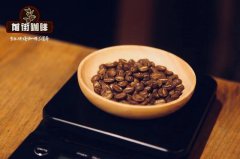What's the meaning of bourbon coffee beans? introduction to Colombian powder bourbon flavor

Professional coffee knowledge exchange more coffee bean information please follow the coffee workshop (Wechat official account cafe_style)
Brief introduction of Qianjie bourbon variety and Colombian Isabella coffee
Bourbon has the same tall and conical shape as the tin pickup, but it has more secondary branches and is thicker. The main trunk and branches are thicker, so they are stronger than tin cards and are relatively less flexible. The branches are denser, and this increase in density means that bourbon can produce about 30% more coffee cherries than tin pickle.
The bourbon leaves are wider and rougher than tin cards, and the edges of the leaves are wavy. Young leaves are usually green, but sometimes have bronze tips. Coffee cherries are round and change to a variety of colors when ripe, such as red, orange or yellow (but the color on the same plant is the same).
The output of red bourbon, yellow bourbon, orange bourbon and pink bourbon is less, while that of pink bourbon is very little. Pink bourbon is too rare to be known in the past.
Pink bourbon is a hybrid of yellow bourbon and red bourbon, with strong disease resistance and delicious taste. Compared with other varieties, beans have higher density, and its yield is very low. It is planted between 1500 and 2000 meters above sea level. But the process of cultivating pink bourbon is not an easy task. People need careful care during the whole growth period of coffee trees, and the planting environment is also higher. Another challenge is harvesting. It is difficult for workers to tell whether they are mature or not when harvesting. The main reason is that yellow genes and red genes of red bourbon are both recessive genes, which are easy to interfere with each other and make pink bourbon not easy to produce. In addition, pink bourbon is very similar to immature red bourbon. It is not easy to recognize and is often mixed together, which is why pink bourbon is rare.
Two kinds of common bourbon (red bourbon and yellow bourbon)
Red bourbon
As early as 1850, Brazil became the world's leading producer of coffee. They relied heavily on the tin card introduced in 1720, but the yield of the beans was low. In order to ensure profits, they introduced bourbon, that is, red bourbon, from Reunion, and planted it on a large scale.
After the red bourbon coffee tree blossoms and bears fruit, the color change of coffee fruit is from green > to yellowish > to light orange > to ripe red > to ripe dark red, which is what we call bourbon species. Planted in bourbon at high altitude, it usually has a better aroma and bright acidity, and even tastes like red wine.
Yellow bourbon
Yellow bourbon is a unique bourbon variety in the state of Sao Paulo, Brazil. the fruit of coffee does not turn red after ripening, but orange, so it is called "yellow bourbon". Because of its low yield and relatively intolerant to wind and rain, it has not been widely planted. The yellow bourbon planted at high altitude will have a great flavor.
Taste characteristics: sweet and smooth fruit sweetness, obvious nutty flavor, balanced and supple acidity, weak and clean bitterness, rich chocolate aroma and nutty flavor, bright and fresh taste.
Isabella of Colombia
Place of Origin。 San Adolfo, Acevedo, Huila, Colombia
A processing plant. A group of small producers
Altitude. 1700-1800 Meters
Bean seed. Pink Bourbon / powder bourbon species
How to deal with it. Fully Washed / washing
Harvest and processing time. 2018 / 2019
Baking degree. Light / shallow baking
END
Important Notice :
前街咖啡 FrontStreet Coffee has moved to new addredd:
FrontStreet Coffee Address: 315,Donghua East Road,GuangZhou
Tel:020 38364473
- Prev

What are the differences between tin pickup and bourbon? what are the flavor and taste characteristics of bourbon coffee?
Professional coffee knowledge exchange more coffee bean information please pay attention to the coffee workshop (Wechat official account cafe_style) the difference between iron pickup and bourbon in the front street, introduction to Queen's Manor Coffee of Brazil Typica: a native species derived from Ethiopia, flattened in shape; weak resistance, susceptible to leaf rust; low yield. Bourbon Bourbon: found on the island of Bourbon
- Next

How is the Colombian flavor of pink bourbon? how to share powder bourbon by hand?
Professional coffee knowledge exchange more coffee bean information please follow the coffee workshop (Wechat official account cafe_style) the front street Columbia pink bourbon coffee brewing sharing pink bourbon is a hybrid of red bourbon and yellow bourbon, the success rate of mixing is relatively low, so the number of pink bourbon is relatively rare, it has a strong disease resistance. Among them, yellow bourbon and red bourbon coffee are more stable in reproduction.
Related
- Beginners will see the "Coffee pull flower" guide!
- What is the difference between ice blog purified milk and ordinary milk coffee?
- Why is the Philippines the largest producer of crops in Liberia?
- For coffee extraction, should the fine powder be retained?
- How does extracted espresso fill pressed powder? How much strength does it take to press the powder?
- How to make jasmine cold extract coffee? Is the jasmine + latte good?
- Will this little toy really make the coffee taste better? How does Lily Drip affect coffee extraction?
- Will the action of slapping the filter cup also affect coffee extraction?
- What's the difference between powder-to-water ratio and powder-to-liquid ratio?
- What is the Ethiopian local species? What does it have to do with Heirloom native species?

